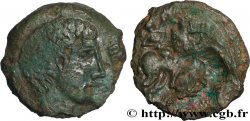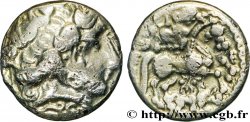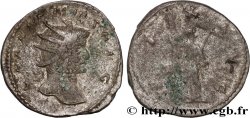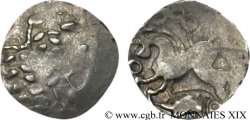v19_0455 - GALLIA - AULERCI EBUROVICES (Regione d'Evreux) Denier scyphate au cheval et au sanglier
MONNAIES 19 (2004)
Начальная цена : 200.00 €
Назначить цену : 500.00 €
Цена реализации : 200.00 €
Количество ставок : 1
Максимальная предлагаемая цена : 260.00 €
Начальная цена : 200.00 €
Назначить цену : 500.00 €
Цена реализации : 200.00 €
Количество ставок : 1
Максимальная предлагаемая цена : 260.00 €
Тип Denier scyphate au cheval et au sanglier
Дата: c. 50-40 AC.
Монетный двор / Город: Évreux (27)
Металл: silver
Диаметр: 13,5 mm
Ориентация осей монеты: 7 h.
Вес: 0,68 g.
Редкость: R3
Комментарии о состоянии
Très bel exemplaire pour ce type de petite monnaie en argent, souvent mal conservé. Frappe vigoureuse au revers, avec des débuts de cassures de coin sur le revers
Происхождение:
Cet exemplaire provient du stock Argenor
Лицевая сторона
Аверс: легенда: ANÉPIGRAPHE.
Аверс: описание: Restes de tête humaine, surmontées par une couronne de laurier sur laquelle est posé un petit sanglier à gauche.
Обратная сторона
Реверс: легенда: ANÉPIGRAPHE.
Реверс: Описание: Cheval galopant à gauche ; au-dessous, un petit sanglier tourné à gauche ; un annelet au-dessus et devant le cheval.
Комментарий
Cet exemplaire semble être le second connu après celui proposé dans MONNAIES XVIII, n° 865, ils sont tous deux de même coin de revers, mais celui-ci est d'une frappe antérieure, avec des cassures de coin moins prononcées. Cet exemplaire présente un annelet bien net devant le cheval. Au-dessus du cheval, on distingue trois annelets partant de la hampe, alors qu'un seul était visible sur celui de MONNAIES XVIII.
This example appears to be the second known after the one proposed in MONNAIES XVIII, No. 865. They both have the same reverse die, but this one is from an earlier strike, with less pronounced die breaks. This example has a very clear annulet in front of the horse. Above the horse, three annulets extending from the shaft can be seen, whereas only one was visible on the one in MONNAIES XVIII.
This example appears to be the second known after the one proposed in MONNAIES XVIII, No. 865. They both have the same reverse die, but this one is from an earlier strike, with less pronounced die breaks. This example has a very clear annulet in front of the horse. Above the horse, three annulets extending from the shaft can be seen, whereas only one was visible on the one in MONNAIES XVIII.








 Cообщить об ошибке
Cообщить об ошибке Распечатать страницу
Распечатать страницу Отправить мой выбор
Отправить мой выбор Задать вопрос
Задать вопрос Consign / sell
Consign / sell
 Информация
Информация














